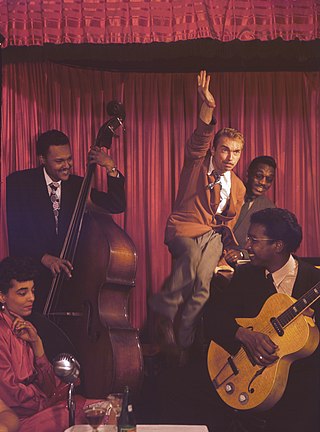Jive may refer to:
Jive may refer to:
This is a list of notable events in music that took place in the year 1986.

Swing dance is a group of social dances that developed with the swing style of jazz music in the 1920s–1940s, with the origins of each dance predating the popular "swing era". Hundreds of styles of swing dancing were developed; those that have survived beyond that era include Charleston, Balboa, Lindy Hop, and Collegiate Shag. Today, the best-known of these dances is the Lindy Hop, which originated in Harlem in the early 1930s. While the majority of swing dances began in African-American communities as vernacular African-American dances, some influenced swing-era dances, like Balboa, developed outside of these communities.
Swing music is a style of jazz that developed in the United States during the late 1920s and early 1930s. It became nationally popular from the mid-1930s. The name derived from its emphasis on the off-beat, or nominally weaker beat. Swing bands usually featured soloists who would improvise on the melody over the arrangement. The danceable swing style of big bands and bandleaders such as Benny Goodman was the dominant form of American popular music from 1935 to 1946, known as the swing era, when people were dancing the Lindy Hop. The verb "to swing" is also used as a term of praise for playing that has a strong groove or drive. Musicians of the swing era include Duke Ellington, Benny Goodman, Count Basie, Cab Calloway, Benny Carter, Jimmy Dorsey, Tommy Dorsey, Woody Herman, Earl Hines, Harry James, Lionel Hampton, Glenn Miller, Artie Shaw, Jimmie Lunceford, and Django Reinhardt.

The United States' multi-ethnic population is reflected through a diverse array of styles of music. It is a mixture of music influenced by the music of Europe, Indigenous peoples, West Africa, Latin America, Middle East, North Africa, amongst many other places. The country's most internationally renowned genres are traditional pop, jazz, blues, country, bluegrass, rock, rock and roll, R&B, pop, hip-hop/rap, soul, funk, religious, disco, house, techno, ragtime, doo-wop, folk, americana, boogaloo, tejano, surf, and salsa, amongst many others. American music is heard around the world. Since the beginning of the 20th century, some forms of American popular music have gained a near global audience.

Jive Records was a British-American independent record label founded by Clive Calder in 1981 as a subsidiary of the Zomba Group. In the US, the label had offices in New York City and Chicago. Jive was best known for its successes with hip hop, R&B, and dance acts in the 1980s and 1990s, along with teen pop and boy bands during the late 1990s and early 2000s.

The South African music scene includes both popular (jive) and folk forms like Zulu isicathamiya singing and harmonic mbaqanga. Other popular genres are marabi, kwaito,house music, pop music, isicathamiya, gqom, rock music, hip hop and amapiano.

The rich and varied music of Sudan has traditional, rural, northeastern African roots and also shows Arabic, Western or other African influences, especially on the popular urban music from the early 20th century onwards. Since the establishment of big cities like Khartoum as melting pots for people of diverse backgrounds, their cultural heritage and tastes have shaped numerous forms of modern popular music. In the globalized world of today, the creation and consumption of music through satellite TV or on the Internet is a driving force for cultural change in Sudan, popular with local audiences as well as with Sudanese living abroad.
Style is a manner of doing or presenting things and may refer to:

Harry "The Hipster" Gibson, born Harry Raab, was an American jazz pianist, singer, and songwriter. He played New York style stride piano and boogie woogie while singing in a wild, unrestrained style. His music career began in the late 1920s, when, under his real name, he played stride piano in Dixieland jazz bands in Harlem. He continued to perform there throughout the 1930s, adding the barrelhouse boogie of the time to his repertoire.

The jive is a dance style that originated in the United States from African Americans in the early 1930s. The name of the dance comes from the name of a form of African-American vernacular slang, popularized in the 1930s by the publication of a dictionary by Cab Calloway, the famous jazz bandleader and singer. In competition ballroom dancing, the jive is often grouped with the Latin-inspired ballroom dances, though its roots are based on swing dancing and not Latin dancing.
The Renaissance was a period in European history in the 15th and 16th centuries, characterized by an effort to revive and surpass ideas and achievements of classical antiquity. It initially developed from the Italian Renaissance.

Afro-Cubans or Black Cubans are Cubans of full or partial sub-Saharan African ancestry. The term Afro-Cuban can also refer to historical or cultural elements in Cuba associated with this community, and the combining of native African and other cultural elements found in Cuban society, such as race, religion, music, language, the arts and class culture.

The European VLBI Network (EVN) is a network of radio telescopes located primarily in Europe and Asia, with additional antennas in South Africa and Puerto Rico, which performs very high angular resolution observations of cosmic radio sources using very-long-baseline interferometry (VLBI). The EVN is the most sensitive VLBI array in the world, and the only one capable of real-time observations. The Joint Institute for VLBI ERIC (JIVE) acts as the central organisation in the EVN, providing both scientific user support and a correlator facility. Very Long Baseline Interferometry (VLBI) achieves ultra-high angular resolution and is a multi-disciplinary technique used in astronomy, geodesy and astrometry.
The Memphis Jug Band was an American musical group active from the mid-1920s to the late-1950s. The band featured harmonica, kazoo, fiddle and mandolin or banjolin, backed by guitar, piano, washboard, washtub bass and jug. They played slow blues, pop songs, humorous songs and upbeat dance numbers with jazz and string band flavors. The band made the first commercial recordings in Memphis, Tennessee, and recorded more sides than any other prewar jug band.

The Zomba Group of Companies was a music group and division owned by and operated under Sony Music Entertainment. The division was renamed to Jive Label Group in 2009 and was placed under the RCA/Jive Label Group umbrella. In 2011, the RCA/Jive Label Group was split in half. Multiple Jive Label Group artists were moved to Epic Records while others stayed with Jive as it moved under the RCA Music Group. In October 2011 Jive Records was shut down and their artists were moved to RCA Records.

"Deeper Shade of Blue" is a song by British dance-pop group Steps, released as the fourth single from their second studio album, Steptacular (1999), on 3 April 2000. The song was originally recorded by English singer-songwriter Tina Cousins, but aside from a few promotional 12-inch vinyl discs pressed in 1998, her version remains unreleased. "Deeper Shade of Blue" entered the UK Singles Chart at number four and spent one more week in the top 10 before falling down the charts. After a total of nine weeks, it left the top 100.

The terms hipster or hepcat, as used in the 1940s, referred to aficionados of jump blues and jazz, in particular bebop, which became popular in the early 1940s. The hipster subculture adopted the lifestyle of the jazz musician, including some or all of the following features: Conk hairstyles, loose fitting suits with loud colors, jive talk slang, use of tobacco, cannabis, and other recreational drugs, relaxed attitude, love for Jazz or Jump blues music, and styles of swing dancing, especially Lindy hop.
Jive talk, also known as Harlem jive or simply Jive, the argot of jazz, jazz jargon, vernacular of the jazz world, slang of jazz, and parlance of hip is an African-American Vernacular English slang or vocabulary that developed in Harlem, where "jive" (jazz) was played and was adopted more widely in African-American society, peaking in the 1940s.
Jaiva, Township jive (TJ), Soweto jive, Soweto sound or Soweto beat is a subgenre of South African township music and African dance form that influenced Western breakdance and emerged from the shebeen culture of the apartheid-era townships.